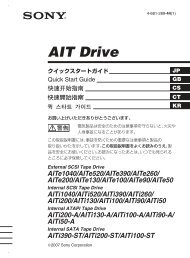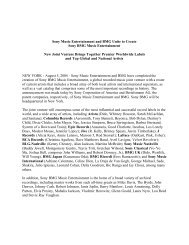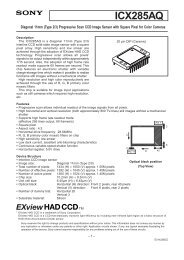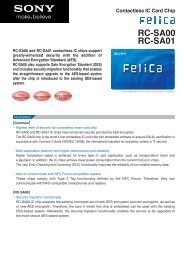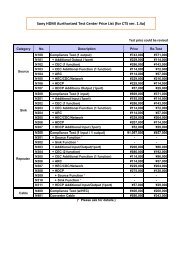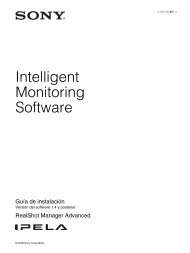PDF [4833KB] - Sony
PDF [4833KB] - Sony
PDF [4833KB] - Sony
You also want an ePaper? Increase the reach of your titles
YUMPU automatically turns print PDFs into web optimized ePapers that Google loves.
In December 2003, <strong>Sony</strong> and Bertelsmann<br />
AG signed a binding agreement to combine<br />
their recorded music businesses in a joint venture.<br />
The newly formed company, which will<br />
be known as <strong>Sony</strong> BMG, will be 50 percent<br />
owned by each parent company. The merger is<br />
subject to regulatory approvals in the U.S. and<br />
European Union.<br />
In order to fulfill its commitments, <strong>Sony</strong><br />
will use cash generated by its operating activities,<br />
net excess cash within the <strong>Sony</strong> group<br />
through group finance subsidiaries such as<br />
SGTS and raise funds from the global capital<br />
markets and from banks when necessary.<br />
OFF-BALANCE SHEET ARRANGEMENTS<br />
During the fiscal year ended March 31, 2004,<br />
<strong>Sony</strong> entered into a new accounts receivable<br />
securitization program which provides for the<br />
accelerated receipt of up to 500 million U.S.<br />
dollars of cash on eligible trade accounts<br />
receivable of <strong>Sony</strong>’s U.S. electronics subsidiary<br />
and replaced the previous accounts receivable<br />
securitization program which provided for the<br />
accelerated receipt of up to 900 million U.S.<br />
dollars. Through this program, <strong>Sony</strong> can<br />
securitize and sell a percentage of undivided<br />
interest in that pool of receivables to several<br />
multi-seller commercial paper conduits owned<br />
and operated by a bank. These securitization<br />
transactions are accounted for as a sale in<br />
accordance with Statement of Financial<br />
Accounting Standards (“FAS”) No. 140,<br />
“Accounting for Transfers and Servicing of<br />
Financial Assets and Extinguishments of Liabilities”,<br />
because <strong>Sony</strong> has relinquished control of<br />
the receivables. Accordingly, accounts receivable<br />
sold under these facilities are excluded from<br />
receivables in the accompanying consolidated<br />
balance sheet. There were no amounts outstanding<br />
under this facility at March 31, 2004.<br />
<strong>Sony</strong> has, from time to time, entered into<br />
various financing arrangements with VIEs. These<br />
arrangements include facilities which provide<br />
for the leasing of certain property, the financing<br />
of film production and the development and<br />
operation of a multi-use real estate complex.<br />
Although not a significant part of its financing<br />
activities, <strong>Sony</strong> employs these arrangements<br />
because they provide a diversification of funding<br />
sources. The assets and liabilities associated with<br />
these arrangements previously qualified for offbalance<br />
sheet treatment. On July 1, 2003, <strong>Sony</strong><br />
adopted FIN 46 and accordingly, the assets and<br />
liabilities associated with these arrangements<br />
were consolidated. Refer to Note 22 of Notes to<br />
Consolidated Financial Statements for more information.<br />
As a result, <strong>Sony</strong> recognized a one<br />
time charge with no tax effect of 2.1 billion yen<br />
for a cumulative effect of accounting change.<br />
Additionally, <strong>Sony</strong>’s assets and liabilities increased<br />
as non-cash transactions, which resulted<br />
in no cash flows, by 95.3 billion yen and 98.0<br />
billion yen, respectively. Cash and cash equivalents<br />
also increased by 1.5 billion yen. For all the<br />
VIEs in which <strong>Sony</strong> holds a significant variable<br />
interest <strong>Sony</strong> is a primary beneficiary, and all<br />
these VIEs are consolidated by <strong>Sony</strong>.<br />
CASH FLOWS<br />
(The fiscal year ended March 31, 2004 compared<br />
with the fiscal year ended March 31, 2003.)<br />
Operating Activities: During the fiscal year<br />
ended March 31, 2004, <strong>Sony</strong> generated 632.6<br />
billion yen of net cash from operating activities,<br />
a decrease of 221.2 billion yen, or 25.9 percent<br />
compared with the previous fiscal year. Of this<br />
total, all segments excluding the Financial Services<br />
segment generated 401.1 billion yen of<br />
net cash from operating activities, a decrease of<br />
143.0 billion yen, or 26.3 percent, compared<br />
with the previous year, and the Financial<br />
Services segment generated 241.6 billion yen of<br />
net cash from operating activities, a decrease of<br />
73.1 billion yen, or 23.2 percent, compared<br />
with the previous year.<br />
During the fiscal year, profits from the<br />
Game, Financial Services, Pictures and Music<br />
segments, an increase in depreciation expenses,<br />
and an increase in notes and accounts<br />
payable, trade, primarily due to an increase in<br />
the procurement of raw materials and parts<br />
reflecting the increase in sales to outside customers<br />
in the Electronics segment, contributed<br />
to operating cash flow. Partially offsetting<br />
these contributions were factors including an<br />
increase in inventories in the Electronics segment<br />
and an increase in notes and accounts<br />
receivable, trade in the Electronics and Pictures<br />
segments. An increase in future insurance<br />
policy benefits and other, due to an increase in<br />
insurance-in-force, contributed to operating<br />
cash flow in the Financial Services segment.<br />
Compared with the previous fiscal year,<br />
net cash provided by operating activities<br />
decreased, due to a year on year increase in<br />
notes and accounts receivable, trade during<br />
the fiscal year ended March 31, 2004, compared<br />
with a year on year decrease during<br />
the fiscal year ended March 31, 2003. The<br />
increase in notes and accounts receivable,<br />
trade was primarily due to an increase in sales<br />
to outside customers, in the fourth quarter<br />
ended March 31, 2004, of digital still cameras,<br />
flat panel televisions and cellular phones (sold<br />
to <strong>Sony</strong> Ericsson) in the Electronics segment,<br />
as well as home entertainment revenues in the<br />
Pictures segment, compared with the fourth<br />
quarter ended March 31, 2003. Although<br />
certain factors contributed to an increase in<br />
operating cash flow, such as a year on year<br />
increase, during the fiscal year ended March<br />
31, 2004, in notes and accounts payable,<br />
trade, compared with a year on year decrease<br />
in the fiscal year ended March 31, 2003,<br />
mainly due to the increase in the procurement<br />
of raw materials and parts reflecting the<br />
increase in sales to outside customers in the<br />
Electronics segment, these factors were offset<br />
by factors such as an increase in inventories in<br />
the Electronics segment during the fiscal year<br />
ended March 31, 2004 compared with a<br />
decrease in the fiscal year ended March 31,<br />
2003, which decreased operating cash flow.<br />
Investing Activities: During the fiscal year,<br />
<strong>Sony</strong> used 761.8 billion yen of net cash in<br />
investing activities, an increase of 55.4 billion<br />
yen, or 7.8 percent, compared with the<br />
previous fiscal year. Of this total, all segments<br />
excluding the Financial Services segment used<br />
352.5 billion yen of net cash in investing<br />
activities, an increase of 166.6 billion yen, or<br />
89.6 percent, compared with the previous<br />
fiscal year, and the Financial Services segment<br />
used 401.6 billion yen in net cash, a decrease<br />
of 115.1 billion yen, or 22.3 percent.<br />
During the fiscal year, purchases of fixed assets<br />
(capital expenditures) were made, primarily due to<br />
proactive capital expenditures in the Electronics<br />
and Game segments mainly for next generation<br />
broadband microprocessors and CCDs, and payments<br />
for investments and advances exceeded<br />
proceeds in the Financial Services segment due<br />
to an increase in assets under management<br />
(refer to “Financial Services”).<br />
77


![PDF [4833KB] - Sony](https://img.yumpu.com/26420643/79/500x640/pdf-4833kb-sony.jpg)
